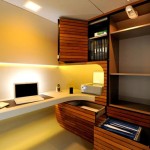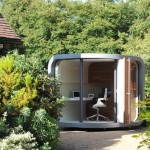The creative man deserves a special kind of man cave, a place to work out the stresses of the day in peace and privacy. And while a big screen tv and sports memorabilia may work for some, the creative dad needs a true creative outlet.
From a wall-sized canvas to a personal recording booth to a 3D printer, the tools of the trade are a lot more exciting and fulfilling to a creative individual.
Join us to explore ways to build a great creative man cave for the artist, musician or tinkerer in you.
View in gallery
[above: the creative space of Dan Tidswell, one of the most shared work spaces on flickr]
Building your man cave: Location, Location, Location
View in gallery
The creative man cave requires a space of its own, preferably as far away from other responsibilities as possible. The challenge is finding available space, and that can be difficult especially in urban environments. The first option is a spare room– an empty bedroom, an office or even a walk-in closet that isn’t in use. If you can close the door and have enough room to relax, you can make this space work. Another frequent option is a basement, but this might require investing a bit more in construction materials. Then there’s an empty spot in the garage. If you have a two or three car garage but only one or two vehicles, that extra space can be used to house your creative man cave. Like your basement, this requires that you furnish a space with wood, dry wall, electrical and otherwise. The final and possibly most exciting option is to actually build out a space in your back yard. An existing shed can be cleaned out, restored and built into a nice creative cave, or a new building can be constructed to suit your needs.
Let’s assume that a spare room is not available, but you’ve determined that you can build a space in a corner of the basement, an empty garage space or a section of your back yard. Building a presentable space is not entirely difficult, and could be something to tackle on your own if you’re a handy individual. Simple wooden frames, dry wall and paint could be all you need before calling an electrician to handle the technical stuff. Doors are a standard size, and videos online can guide you through the easy steps of construction. If you’re not comfortable with building out a few walls and tossing up some ceiling tiles, you can hire a local contractor to do the work for you. It shouldn’t be a hard sell to your better half, as doing so can improve the value of your home and it should clear your creative clutter from the rest of the house.
If you decide that you want to move your man cave outside of the house, the back yard presents an exciting option. There’s a whole movement (and a book) of Shedworking for those who have built offices and living rooms out of the sheds in their back yard. You can also build one to your own spec, buy a kit from a local hardware store or order a prefab unit to be delivered and installed for you. The cheapest option is to restore an existing shed, then to build one of your own and last, to buy a pricey but attractive prefab. The OfficePOD shown above defines “attractive prefab”, and has long been a favorite of ours here at TheCoolist.
OfficePOD Prefab Man Cave Gallery
View in gallery View in gallery
View in gallery View in gallery
View in gallery
So you’ve got your space, the next question is what you fill it with. Since creativity is a varied endeavor, we’ll divide this up between the most common creative disciplines.
Creative Man Cave: the Visual Creative
View in gallery
The visual creative tends to focus on crafting an image– you might be a graphic designer, an illustrator, a photographer or a fine artist. Before we get in to some of the tools of the trade to involve in your creative man cave, we have two considerations to start. First, you may want to focus on creating a minimal environment, one that can be kept clean easily and one that will itself provide visual inspiration. When selecting furniture, wall coverings and otherwise, try to opt for clean, contemporary and functional first. For the wall coverings, we love the Ideapaint shown above, it turns your walls into a creative medium of their own. Next, we suggest you have creative outlets in both digital and traditional mediums. Instead of focusing on Photoshop and Illustrator, you should also have an outlet for oil and canvas, pen and paper, stencil and print. If you work in front of a computer during the day, an escape to hand-made, traditional art will be entirely fulfilling.
Now that the design philosophy is understood, what will you stock your creative man cave with? It’s safe to start with a strong computer with at least one high resolution monitor before you go any further. An Apple iMac is a great solution for a single monitor, and a Mac Pro can scale to a multiple monitor setup in a heartbeat. Any strong PC will do fine, but Apple has long established itself as the creative standard.
View in gallery
Beyond the computer itself, one excellent peripheral to consider is a Wacom tablet, especially the Wacom Cintiq 24HD Touch. This is ideal for visual creatives, providing a hands-on way of drawing, writing and painting directly on to your visual surface. At $3,699 it is a pricey option, but Wacom has low cost options available for display tablets like this and the more basic non-display pen interfaces.
On the traditional, non-computer creative end, we suggest a few key investments. If you skip the Ideapaint shown above, you could invest in a rolling easel like this mobile version from Steelcase. When you explore your desk options, be sure to select something with plenty of space for illustrating, but meets the concept above of “minimal, contemporary, inspiring”. We adore the Table by Beatus Kopp, a desk that features hollow legs that hide cables and cords. Oh, and it’s stunning, which certainly doesn’t hurt.
Last, we didn’t forget about the photographer in you. There are three things you can do beyond your computer to allow for some photographic inspiration. You can build a cyc wall for seamless backgrounds (or use a studio background stand), you can set up a lightbox for product and macro photography, or you can go old school and build your own dark room for developing film. If it’s dark outside and the weather is too cold to enjoy, you can still explore your photographic creativity indoors.
Creative Man Cave: the Musical Creative
View in gallery
While not every creative man cave can have that stunning view of downtown Sydney like Gary Hayes, we can still find plenty of inspiration in his home office. Your direction will of course depend on your instrument of choice as well as the type of sound you wish to create. While Mr. Hayes studio would be ideal for the keyboard-focused, electronic or hip hop focused musician, an acoustic route might look a bit different. Either way, if you’re looking to produce quite a bit of sound, you’ll need to control that sound with acoustic wall treatments, a sonically-neutral recording booth or both. Let’s explore…
Like the visual creative, the musician in you will likely need a computer to handle your raw audio. The options listed above will work well, but a specific peripheral is needed– specifically an audio interface to get your sound into digital format to begin with. A great solution for starters is the Avid Mbox, a device that comes with a light version of the well know Pro Tools audio and MIDI recording software. Depending on how many sound sources you need to record onto your computer at once, these systems can become pretty complex, but if you’re working solo, chances are the Mbox will suit you just fine.
If you’re working with any kind of software synthesizer, drum machine or orchestral library, a keyboard controller is likely a necessity. You may not need all 88 keys like a standard piano, so a few octaves could suffice. A great option for the non-pianist is the Akai MPK49, a 49-key keyboard that includes 12 pads for controlling drum sounds or samples. It’ll sync with most recording/sequencing software instantly, just plug it in via USB and select it in your software environment.
If you’re aiming for an acoustic style, just you and a guitar will work wonders. If you want to record, it’ll be a bit more complicated. The aforementioned acoustic wall treatments, we suggest Auralex studio foam panels, will help create a sonically neutral or at least “attractive” environment to record and practice in. Pro tip– don’t glue them directly to the wall, attach them to sheets that can hang from the wall (otherwise, you’ll never get them off without damaging your walls). Another, more expensive option is to build or buy a recording booth. This would be a smaller room-within-a-room with treated walls for an entirely neutral, nearly silent environment. You’ll be able to record your guitar, your voice or your instrument without ugly reflections or reverberation. Then you’re free to add your own environmental effects in your recording software.
Creative Man Cave: the Tinkerer
View in gallery
So you’re not the most visually inclined, and you can’t hold a note to save your life. That doesn’t mean you aren’t creative, and there’s a world of you out there that are truly gifted at creating with your hands. You’re likely familiar with the device that may be the next revolution in human creativity and industry, the 3D printer. These devices quickly, inexpensively produce three-dimensional objects from designs you render in software environments. That Eifel Tower statue in the image above was designed in software and then printed out with a 3D printer. In this case, the printer is the Form 1 by Formlabs, the device that holds the record for most-funded Kickstarter project in the company’s history. Nearly $3,000,000 was invested by the Kickstarter community to produce this device which has been proven with a working prototype. Eventually, you’ll be able to buy your own for a few thousand dollars, but you’ll have to wait until production is moving forward. There are other 3D printers on the market today, some of them at this level of cost, but you’ll need to do your research to find out which one is right for you. Then, after you’ve set up one of your own, the sky is the limit for what you can create in your own little laboratory.
Beyond the 3D printer, a good old-fashioned work bench might be perfect for you. You can pick up something that can take a beating or a bending from your local hardware or home improvement store. You’ll need to stock it with tools and materials, then you’re good to shape, create and construct anything your heart desires. You can also invest in electronics kits to build your own DIY-thingamajig at your pleasure. Hey, perhaps you can even build your own 3D printer? A tinkerer’s dream is a quiet lab and plenty of materials, and you can achieve that in your own creative man cave.
– – – – – – – – – – –
Get to building, dear creative reader! If you have any tips, ideas or items you think would fit great in a creative man cave, be sure to share it with us in the comments below or send us a tweet @thecoolist. In the mean time, thanks for reading, and we invite you to return to share your creative endeavors with us!

